There are no products in your shopping cart yet.
GND Filters

Gray gradient filters
Loading...
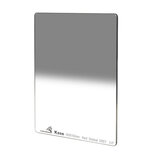
Kase KW100x150 Gradual Hard GND 0.6
GND gray gradient filters have a gradation (gradient) that varies in strength and density across the surface of the glass filter. The filters are often half ND gray filter and the other half is clear. When photographing with long shutter speeds, it is important to be able to control the light. Depending on what you want to block the light from, you can place the gray gradient filter in the correct position. A GND gray gradient filter is often used together with an ND gray filter.
The gray gradient filters have different types of transitions, with different application options.
A soft edge S-GND gray gradient filter is best suited for mountainous, forested or urban environments, where the horizon does not have a flat straight transition.
A medium edge M-GND gray gradient filter can also be used in similar areas to the S-GND, but care must be taken as you need to watch out for dark lines that may appear over trees or buildings.
A hard edge H-GND gray gradient filter is best used in open areas where there is nothing on the horizon, such as coastlines and open plains. With a hard gray gradient filter, the transition from light to dark is clear and fast and is ideal for sea and desert landscapes.
- Kase Wolverine glass with high optical clarity
- Virtually unbreakable
- Nano coatings, which control reflections, repel oil and water, and are mold resistant
- Scratch and shock resistant
- Color neutral
- 0.6 is 2 stops of light reduction
- Thickness 2 mm
- Dimensions 100 x 150 mm
- Hard transition
- Kase Wolverine KW100x150 H-GND0.6 gray gradient filter
- Storage cover
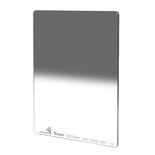
Kase KW100x150 Gradual Hard GND 0.9
GND gray gradient filters have a gradation (gradient) that varies in strength and density across the surface of the glass filter. The filters are often half ND gray filter and the other half is clear. When photographing with long shutter speeds, it is important to be able to control the light. Depending on what you want to block the light from, you can place the gray gradient filter in the correct position. A GND gray gradient filter is often used together with an ND gray filter.
The gray gradient filters have different types of transitions, with different application options.
A soft edge S-GND gray gradient filter is best suited for mountainous, forested or urban environments, where the horizon does not have a flat straight transition.
A medium edge M-GND gray gradient filter can also be used in similar areas to the S-GND, but care must be taken as you need to watch out for dark lines that may appear over trees or buildings.
A hard edge H-GND gray gradient filter is best used in open areas where there is nothing on the horizon, such as coastlines and open plains. With a hard gray gradient filter, the transition from light to dark is clear and fast and is ideal for sea and desert landscapes.
Characteristics
- Kase Wolverine glass with high optical clarity
- Virtually unbreakable
- Nano coatings, which control reflections, repel oil and water, and are mold resistant
- Scratch and shock resistant
- Color neutral
- 0.9 is 3 stops of light reduction
- Thickness 2 mm
- Dimensions 100 x 150 mm
- Hard transition
- Kase Wolverine KW100x150 H-GND0.9 gray gradient filter
- Storage cover

Kase KW100x150 Gradual Soft GND 0.6
GND gray gradient filters have a gradation (gradient) that varies in strength and density across the surface of the glass filter. The filters are often half ND gray filter and the other half is clear. When photographing with long shutter speeds, it is important to be able to control the light. Depending on what you want to block the light from, you can place the gray gradient filter in the correct position. A GND gray gradient filter is often used together with an ND gray filter.
The gray gradient filters have different types of transitions, with different application options.
A soft edge S-GND gray gradient filter is best suited for mountainous, forested or urban environments, where the horizon does not have a flat straight transition.
A medium edge M-GND gray gradient filter can also be used in similar areas to the S-GND, but care must be taken as you need to watch out for dark lines that may appear over trees or buildings.
A hard edge H-GND gray gradient filter is best used in open areas where there is nothing on the horizon, such as coastlines and open plains. With a hard gray gradient filter, the transition from light to dark is clear and fast and is ideal for sea and desert landscapes.
- Kase Wolverine glass with high optical clarity
- Virtually unbreakable
- Nano coatings, which control reflections, repel oil and water, and are mold resistant
- Scratch and shock resistant
- Color neutral
- 0.6 is 2 stops of light reduction
- Thickness 2 mm
- Dimensions 100 x 150 mm
- Soft transition
- Kase Wolverine KW100x150 S-GND 0.6 filter
- Storage cover
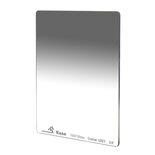
Kase KW100x150 Gradual Soft GND 0.9
GND gray gradient filters have a gradation (gradient) that varies in strength and density across the surface of the glass filter. The filters are often half ND gray filter and the other half is clear. When photographing with long shutter speeds, it is important to be able to control the light. Depending on what you want to block the light from, you can place the gray gradient filter in the correct position. A GND gray gradient filter is often used together with an ND gray filter.
The gray gradient filters have different types of transitions, with different application options.
A soft edge S-GND gray gradient filter is best suited for mountainous, forested or urban environments, where the horizon does not have a flat straight transition.
A medium edge M-GND gray gradient filter can also be used in similar areas to the S-GND, but care must be taken as you need to watch out for dark lines that may appear over trees or buildings.
A hard edge H-GND gray gradient filter is best used in open areas where there is nothing on the horizon, such as coastlines and open plains. With a hard gray gradient filter, the transition from light to dark is clear and fast and is ideal for sea and desert landscapes.
Characteristics
- Kase Wolverine glass with high optical clarity
- Virtually unbreakable
- Nano coatings, which control reflections, repel oil and water, and are mold resistant
- Scratch and shock resistant
- Color neutral
- 0.9 is 3 stops of light reduction
- Thickness 2 mm
- Dimensions 100 x 150 mm
- Soft transition
- Kase Wolverine KW100x150 S-GND0.9 gray gradient filter
- Storage cover

Kase KW100x150 Reverse Gradual R-GND 1.2
R-GND gray gradient filters have a gradient that varies in strength and density across the surface of the glass filter. Half of the filters are clear and the other half is a GND gray gradient filter, which becomes lighter at the top. When photographing with long shutter speeds, it is important to be able to control the light. Depending on what you want to block the light from, you can place the gray gradient filter in the correct position. In a landscape scene the sky is normally brighter than the foreground and at sunrise/sunset a fairly narrow beam of light around the sun is much brighter, so an R-GND filter is placed in front of the lens and moved to a position where the brighter part of the scene is covered by the R-GND filter and the margin between sky and sun, along with the margin between the sun and foreground, are blurred using the transition zones of the R-GND filter. The scene is normally metered for the highlight area and shadow area and the difference in stops dictates the strength of the filter used. Using an R-GND filter avoids the heavy darkening sky normally associated with using stronger GND filters in sunrise/sunset scenes, the transition zones are normally soft.
- Kase Wolverine glass with high optical clarity
- Virtually unbreakable
- Nano coatings, which control reflections, repel oil and water, and are mold resistant
- Scratch and shock resistant
- Color neutral
- 1.2 is 4 stops of light reduction
- Thickness 2 mm
- Dimensions 100 x 150 mm
- Reverse transition
- Kase Wolverine KW100x150 R-GND 1.2 reverse gray gradient filter
- Storage cover

Kase KW100x150 Center Gradual C-GND 1.2
C-GND gray gradient filters have a gradient that varies in strength and density across the surface of the glass filter. The filters are clear and in the middle there is a strip of GND gray gradient filter. When photographing with long shutter speeds, it is important to be able to control the light. Depending on what you want to block the light from, you can place the gray gradient filter in the correct position. At sunrise/sunset a fairly narrow beam of light around the sun is very bright, so a C-GND filter is placed in front of the lens and moved to a position where the brighter part of the scene is covered by the C-GND filter and the margin between light and dark blurred using the transition zones of the C-GND filter. Using a C-GND filter avoids the heavy darkening sky normally associated with using stronger GND filters in sunrise/sunset scenes, the transition zones are normally soft.
- Kase Wolverine glass with high optical clarity
- Virtually unbreakable
- Nano coatings, which control reflections, repel oil and water, and are mold resistant
- Scratch and shock resistant
- Color neutral
- 1.2 is 4 stops of light reduction
- Thickness 2 mm
- Dimensions 100 x 150 mm
- Center transition
- Kase Wolverine KW100x150 C-GND1.2 center gray gradient filter
- Storage cover






Kase KW100x150 Gradual Hard GND 0.75
The gray gradient filters have different types of transitions, with different application options.
A soft edge S-GND gray gradient filter is best suited for mountainous, forested or urban environments, where the horizon does not have a flat straight transition.
A medium edge M-GND gray gradient filter can also be used in similar areas to the S-GND, but care must be taken as you need to watch out for dark lines that may appear over trees or buildings.
A hard edge H-GND gray gradient filter is best used in open areas, where there is nothing on the horizon, such as coastlines and open plains. With a hard gray gradient filter, the transition from light to dark is clear and fast and is ideal for sea and desert landscapes.
Characteristics
- Kase Wolverine glass with high optical clarity
- Virtually unbreakable
- Nano coatings, which control reflections, repel oil and water and are mold resistant
- Scratch and shock resistant
- Color neutral
- 0.75 is just over 2 stops of light reduction
- Thickness 2 mm
- Dimensions 100 x 150 mm
- Hard transition
- Kase Wolverine KW100x150 Gradual Hard GND 0.75 filter
- Storage cover

Kase KW100X150 Gradual Medium GND 0.6
GND gray gradient filters have a gradation (gradient) that varies in strength and density across the surface of the glass filter. The filters are often half ND gray filter and the other half is clear. When photographing with long shutter speeds, it is important to be able to control the light. Depending on what you want to block the light from, you can place the gray gradient filter in the correct position. A GND gray gradient filter is often used together with an ND gray filter.
The gray gradient filters have different types of transitions, with different application options.
A soft edge S-GND gray gradient filter is best suited for mountainous, forested or urban environments, where the horizon does not have a flat straight transition.
A medium edge M-GND gray gradient filter can also be used in similar areas to the S-GND, but care must be taken as you need to watch out for dark lines that may appear over trees or buildings.
A hard edge H-GND gray gradient filter is best used in open areas where there is nothing on the horizon, such as coastlines and open plains. With a hard gray gradient filter, the transition from light to dark is clear and fast and is ideal for sea and desert landscapes.
Characteristics:
- Kase Wolverine glass with high optical clarity
- Virtually unbreakable
- Nano coatings, which control reflections, repel oil and water, and are mold resistant
- Scratch and shock resistant
- Color neutral
- 0.6 is 2 stops of light reduction
- Thickness 2 mm
- Dimensions 100 x 150 mm
- Medium transition
- Kase Wolverine KW100X150 M-GND 0.6 gray gradient filter
- Storage cover

Kase KW100x150 Gradual Medium GND 0.9
GND gray gradient filters have a gradation (gradient) that varies in strength and density across the surface of the glass filter. The filters are often half ND gray filter and the other half is clear. When photographing with long shutter speeds, it is important to be able to control the light. Depending on what you want to block the light from, you can place the gray gradient filter in the correct position. A GND gray gradient filter is often used together with an ND gray filter.
The gray gradient filters have different types of transitions, with different application options.
A soft edge S-GND gray gradient filter is best suited for mountainous, forested or urban environments, where the horizon does not have a flat straight transition.
A medium edge M-GND gray gradient filter can also be used in similar areas to the S-GND, but care must be taken as you need to watch out for dark lines that may appear over trees or buildings.
A hard edge H-GND gray gradient filter is best used in open areas, where there is nothing on the horizon, such as coastlines and open plains. With a hard gray gradient filter, the transition from light to dark is clear and fast and is ideal for sea and desert landscapes.
Characteristics:
- Kase Wolverine glass with high optical clarity
- Virtually unbreakable
- Nano coatings, which control reflections, repel oil and water, and are mold resistant
- Scratch and shock resistant
- Color neutral
- 0.9 is 3 stops of light reduction
- Thickness 2 mm
- Dimensions 100 x 150 mm
- Medium transition
- Kase Wolverine KW100x150 M-GND0.9 gray gradient filter
- Storage cover
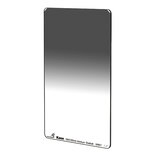
Kase KW100x150 Gradual Medium GND 1.2
GND gray gradient filters have a gradation (gradient) that varies in strength and density across the surface of the glass filter. The filters are often half ND gray filter and the other half is clear. When photographing with long shutter speeds, it is important to be able to control the light. Depending on what you want to block the light from, you can place the gray gradient filter in the correct position. A GND gray gradient filter is often used together with an ND gray filter.
The gray gradient filters have different types of transitions, with different application options.
A soft edge S-GND gray gradient filter is best suited for mountainous, forested or urban environments, where the horizon does not have a flat straight transition.
A medium edge M-GND gray gradient filter can also be used in similar areas to the S-GND, but care must be taken as you need to watch out for dark lines that may appear over trees or buildings.
A hard edge H-GND gray gradient filter is best used in open areas where there is nothing on the horizon, such as coastlines and open plains. With a hard gray gradient filter, the transition from light to dark is clear and fast and is ideal for sea and desert landscapes.
- Kase Wolverine glass with high optical clarity
- Virtually unbreakable
- Nano coatings, which control reflections, repel oil and water, and are mold resistant
- Scratch and shock resistant
- Color neutral
- 1.2 is 4 stops of light reduction
- Thickness 2 mm
- Dimensions 100 x 150 mm
- Medium transition
- Kase Wolverine KW100x150 M-GND1.2 gray gradient filter
- Storage cover

Kase KW100x150 Gradual Soft GND 1.2
GND gray gradient filters have a gradation (gradient) that varies in strength and density across the surface of the glass filter. The filters are often half ND gray filter and the other half is clear. When photographing with long shutter speeds, it is important to be able to control the light. Depending on what you want to block the light from, you can place the gray gradient filter in the correct position. A GND gray gradient filter is often used together with an ND gray filter.
The gray gradient filters have different types of transitions, with different application options.
A soft edge S-GND gray gradient filter is best suited for mountainous, forested or urban environments, where the horizon does not have a flat straight transition.
A medium edge M-GND gray gradient filter can also be used in similar areas to the S-GND, but care must be taken as you need to watch out for dark lines that may appear over trees or buildings.
A hard edge H-GND gray gradient filter is best used in open areas where there is nothing on the horizon, such as coastlines and open plains. With a hard gray gradient filter, the transition from light to dark is clear and fast and is ideal for sea and desert landscapes.
Characteristics
- Kase Wolverine glass with high optical clarity
- Virtually unbreakable
- Nano coatings, which control reflections, repel oil and water, and are mold resistant
- Scratch and shock resistant
- Color neutral
- 1.2 is 4 stops of light reduction
- Thickness 2 mm
- Dimensions 100 x 150 mm
- Soft transition
- Kase Wolverine KW100x150 S-GND1.2 gray gradient filter
- Storage cover

Kase KW100x150 Gradual Soft GND 1.5
GND gray gradient filters have a gradation (gradient) that varies in strength and density across the surface of the glass filter. The filters are often half ND gray filter and the other half is clear. When photographing with long shutter speeds, it is important to be able to control the light. Depending on what you want to block the light from, you can place the gray gradient filter in the correct position. A GND gray gradient filter is often used together with an ND gray filter.
The gray gradient filters have different types of transitions, with different application options.
A soft edge S-GND gray gradient filter is best suited for mountainous, forested or urban environments, where the horizon does not have a flat straight transition.
A medium edge M-GND gray gradient filter can also be used in similar areas to the S-GND, but care must be taken as you need to watch out for dark lines that may appear over trees or buildings.
A hard edge H-GND gray gradient filter is best used in open areas where there is nothing on the horizon, such as coastlines and open plains. With a hard gray gradient filter, the transition from light to dark is clear and fast and is ideal for sea and desert landscapes.
Characteristics:
- Kase Wolverine glass with high optical clarity
- Virtually unbreakable
- Nano coatings, which control reflections, repel oil and water, and are mold resistant
- Scratch and shock resistant
- Color neutral
- 1.5 is 5 stops of light reduction
- Thickness 2 mm
- Dimensions 100 x 150 mm
- Soft transition
- Kase Wolverine KW100x150 S-GND 1.5 gray gradient filter
- Storage cover



Kase KW100x150 PRO1.1 Gradual Hard GND 0.6
GND gray gradient filters have a gradation (gradient) that varies in strength and density across the surface of the glass filter. The filters are often half ND gray filter and the other half is clear. When photographing with long shutter speeds, it is important to be able to control the light. Depending on what you want to block the light from, you can place the gray gradient filter in the correct position. A GND gray gradient filter is often used together with an ND gray filter.
The gray gradient filters have different types of transitions, with different application options.
A soft edge S-GND gray gradient filter is best suited for mountainous, forested or urban environments, where the horizon does not have a flat straight transition.
A medium edge M-GND gray gradient filter can also be used in similar areas to the S-GND, but care must be taken as you need to watch out for dark lines that may appear over trees or buildings.
A hard edge H-GND gray gradient filter is best used in open areas where there is nothing on the horizon, such as coastlines and open plains. With a hard gray gradient filter, the transition from light to dark is clear and fast and is ideal for sea and desert landscapes.
PRO1.1 filters are thinner, lighter and brighter than 2.0 filters
Characteristics
- Kase Wolverine glass with high optical clarity
- Virtually unbreakable
- Nano coatings, which control reflections, repel oil and water, and are mold resistant
- Color neutral
- Scratch and shock resistant
- Light reduction 2 stops
- Dimensions 100x150 mm
- Thickness 1.1 mm
- Hard transition
- Kase Wolverine KW100x150 PRO1.1 H-GND 0.6 gray gradient filter
- Storage cover



Kase KW100x150 PRO1.1 Gradual Medium GND 0.9
GND gray gradient filters have a gradation (gradient) that varies in strength and density across the surface of the glass filter. The filters are often half ND gray filter and the other half is clear. When photographing with long shutter speeds, it is important to be able to control the light. Depending on what you want to block the light from, you can place the gray gradient filter in the correct position. A GND gray gradient filter is often used together with an ND gray filter.
The gray gradient filters have different types of transitions, with different application options.
A soft edge S-GND gray gradient filter is best suited for mountainous, forested or urban environments, where the horizon does not have a flat straight transition.
A medium edge M-GND gray gradient filter can also be used in similar areas to the S-GND, but care must be taken as you need to watch out for dark lines that may appear over trees or buildings.
A hard edge H-GND gray gradient filter is best used in open areas where there is nothing on the horizon, such as coastlines and open plains. With a hard gray gradient filter, the transition from light to dark is clear and fast and is ideal for sea and desert landscapes.
PRO1.1 filters are thinner, lighter and brighter than 2.0 filters
- Kase Wolverine glass with high optical clarity
- Virtually unbreakable
- Nano coatings, which control reflections, repel oil and water, and are mold resistant
- Color neutral
- Scratch and shock resistant
- Light reduction 3 stops
- Dimensions 100x150 mm
- Thickness 1.1 mm
- Medium transition
- Kase Wolverine KW100x150 PRO1.1 M-GND 0.9 gray gradient filter
- Storage cover



Kase KW100x150 PRO1.1 Gradual Soft GND 0.6
GND gray gradient filters have a gradation (gradient) that varies in strength and density across the surface of the glass filter. The filters are often half ND gray filter and the other half is clear. When photographing with long shutter speeds, it is important to be able to control the light. Depending on what you want to block the light from, you can place the gray gradient filter in the correct position. A GND gray gradient filter is often used together with an ND gray filter.
The gray gradient filters have different types of transitions, with different application options.
A soft edge S-GND gray gradient filter is best suited for mountainous, forested or urban environments, where the horizon does not have a flat straight transition.
A medium edge M-GND gray gradient filter can also be used in similar areas to the S-GND, but care must be taken as you need to watch out for dark lines that may appear over trees or buildings.
A hard edge H-GND gray gradient filter is best used in open areas where there is nothing on the horizon, such as coastlines and open plains. With a hard gray gradient filter, the transition from light to dark is clear and fast and is ideal for sea and desert landscapes.
PRO1.1 filters are thinner, lighter and brighter than 2.0 filters
Characteristics:
- Kase Wolverine glass with high optical clarity
- Virtually unbreakable
- Nano coatings, which control reflections, repel oil and water, and are mold resistant
- Color neutral
- Scratch and shock resistant
- Light reduction 2 stops
- Dimensions 100x150 mm
- Thickness 1.1 mm
- Soft transition
- Kase Wolverine KW100x150 PRO1.1 S-GND0.6 gray gradient filter
- Storage cover



Kase KW100x150 PRO1.1 Gradual Soft GND 0.9
GND gray gradient filters have a gradation (gradient) that varies in strength and density across the surface of the glass filter. The filters are often half ND gray filter and the other half is clear. When photographing with long shutter speeds, it is important to be able to control the light. Depending on what you want to block the light from, you can place the gray gradient filter in the correct position. A GND gray gradient filter is often used together with an ND gray filter.
The gray gradient filters have different types of transitions, with different application options.
A soft edge S-GND gray gradient filter is best suited for mountainous, forested or urban environments, where the horizon does not have a flat straight transition.
A medium edge M-GND gray gradient filter can also be used in similar areas to the S-GND, but care must be taken as you need to watch out for dark lines that may appear over trees or buildings.
A hard edge H-GND gray gradient filter is best used in open areas, where there is nothing on the horizon, such as coastlines and open plains. With a hard gray gradient filter, the transition from light to dark is clear and fast and is ideal for sea and desert landscapes.
PRO1.1 filters are thinner, lighter and brighter than 2.0 filters
Characteristics
- Kase Wolverine glass with high optical clarity
- Virtually unbreakable
- Nano coatings, which control reflections, repel oil and water and are mold resistant
- Color neutral
- Scratch and shock resistant
- Light reduction 3 stops
- Dimensions 100x150 mm
- Thickness 1.1 mm
- Soft transition
- Kase Wolverine KW100x150 PRO1.1 S-GND 0.9 gray gradient filter
- Storage cover
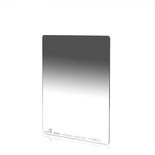


Kase KW100X150 PRO1.1 Gradual Soft GND 1.2
GND gray gradient filters have a gradation (gradient) that varies in strength and density across the surface of the glass filter. The filters are often half ND gray filter and the other half is clear. When photographing with long shutter speeds, it is important to be able to control the light. Depending on what you want to block the light from, you can place the gray gradient filter in the correct position. A GND gray gradient filter is often used together with an ND gray filter.
The gray gradient filters have different types of transitions, with different application options.
A soft edge S-GND gray gradient filter is best suited for mountainous, forested or urban environments, where the horizon does not have a flat straight transition.
A medium edge M-GND gray gradient filter can also be used in similar areas to the S-GND, but care must be taken as you need to watch out for dark lines that may appear over trees or buildings.
A hard edge H-GND gray gradient filter is best used in open areas, where there is nothing on the horizon, such as coastlines and open plains. With a hard gray gradient filter, the transition from light to dark is clear and fast and is ideal for sea and desert landscapes.
PRO1.1 filters are thinner, lighter and brighter than 2.0 filters
- Kase Wolverine glass with high optical clarity
- Virtually unbreakable
- Nano coatings, which control reflections, repel oil and water and are mold resistant
- Color neutral
- Scratch and shock resistant
- Light reduction 4 stops
- Dimensions 100x150 mm
- Thickness 1.1 mm
- Soft transition
- Kase Wolverine KW100X150 PRO1.1 S-GND1.2 gray gradient filter
- Storage cover


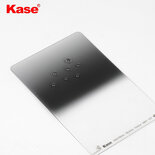

Kase KW100x150 PRO1.1 Reverse Gradual R-GND 0.9
R-GND gray gradient filters have a gradient that varies in strength and density across the surface of the glass filter. Half of the filters are clear and the other half is a GND gray gradient filter, which becomes lighter at the top. When photographing with long shutter speeds, it is important to be able to control the light. Depending on what you want to block the light from, you can place the gray gradient filter in the correct position. In a landscape scene the sky is normally brighter than the foreground and at sunrise/sunset a fairly narrow beam of light around the sun is much brighter, so an R-GND filter is placed in front of the lens and moved to a position where the brighter part of the scene is covered by the R-GND filter and the margin between sky and sun, along with the margin between the sun and foreground, are blurred using the transition zones of the R-GND filter. The scene is normally metered for the highlight area and shadow area and the difference in stops dictates the strength of the filter used. Using an R-GND filter avoids the heavy darkening sky normally associated with using stronger GND filters in sunrise/sunset scenes, the transition zones are normally soft.
PRO1.1 filters are thinner, lighter and brighter than 2.0 filters
- Kase Wolverine glass with high optical clarity
- Virtually unbreakable
- Nano coatings, which control reflections, repel oil and water and are mold resistant
- Color neutral
- Scratch and shock resistant
- Light reduction 3 stops
- Dimensions 100x150 mm
- Thickness 1.1 mm
- Reverse transition
- Kase Wolverine KW100x150 Slim R-GND 0.9 reverse gray gradient filter
- Storage cover



Kase KW100x150 PRO1.1 Reverse Gradual R-GND 1.2
R-GND gray gradient filters have a gradient that varies in strength and density across the surface of the glass filter. Half of the filters are clear and the other half is a GND gray gradient filter, which becomes lighter at the top. When photographing with long shutter speeds, it is important to be able to control the light. Depending on what you want to block the light from, you can place the gray gradient filter in the correct position. In a landscape scene the sky is normally brighter than the foreground and at sunrise/sunset a fairly narrow beam of light around the sun is much brighter, so an R-GND filter is placed in front of the lens and moved to a position where the brighter part of the scene is covered by the R-GND filter and the margin between sky and sun, along with the margin between the sun and foreground, are blurred using the transition zones of the R-GND filter. The scene is normally metered for the highlight area and shadow area and the difference in stops dictates the strength of the filter used. Using an R-GND filter avoids the heavy darkening sky normally associated with using stronger GND filters in sunrise/sunset scenes, the transition zones are normally soft.
PRO1.1 filters are thinner, lighter and brighter than 2.0 filters
- Kase Wolverine glass with high optical clarity
- Virtually unbreakable
- Nano coatings, which control reflections, repel oil and water, and are mold resistant
- Color neutral
- Scratch and shock resistant
- Light reduction 4 stops
- Dimensions 100x150 mm
- Thickness 1.1 mm
- Reverse transition
- Kase Wolverine KW100x150 PRO1.1 R-GND1.2 reverse gray gradient filter
- Storage cover

Kase KW100x150 Reverse Gradual R-GND 0.9
R-GND gray gradient filters have a gradient that varies in strength and density across the surface of the glass filter. Half of the filters are clear and the other half is a GND gray gradient filter, which becomes lighter at the top. When photographing with long shutter speeds, it is important to be able to control the light. Depending on what you want to block the light from, you can place the gray gradient filter in the correct position. In a landscape scene the sky is normally brighter than the foreground and at sunrise/sunset a fairly narrow beam of light around the sun is much brighter, so an R-GND filter is placed in front of the lens and moved to a position where the brighter part of the scene is covered by the R-GND filter and the margin between sky and sun, along with the margin between the sun and foreground, are blurred using the transition zones of the R-GND filter. The scene is normally metered for the highlight area and shadow area and the difference in stops dictates the strength of the filter used. Using an R-GND filter avoids the heavy darkening sky normally associated with using stronger GND filters in sunrise/sunset scenes, the transition zones are normally soft.
- Kase Wolverine glass with high optical clarity
- Virtually unbreakable
- Nano coatings, which control reflections, repel oil and water, and are mold resistant
- Scratch and shock resistant
- Color neutral
- 0.9 is 3 stops of light reduction
- Thickness 2 mm
- Dimensions 100 x 150 mm
- Reverse transition
- Kase Wolverine KW100x150 R-GND0.9 reverse gray gradient filter
- Storage cover
Gray gradient filters have a gradation, which varies in strength and density across the surface of the glass filter. The filters are often half ND filter and the other half is clear, the gradient is referred to as soft edge (soft), medium edge (medium), or hard edge (hard). There are also filters that are half ND, but become lighter at the top, Reverse GND filter, or only have an ND strip in the middle, Center GND filter.
For more information about gray gradient filters: Click here
